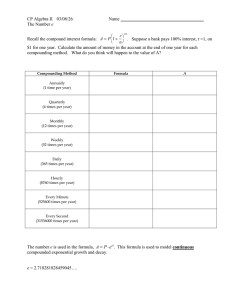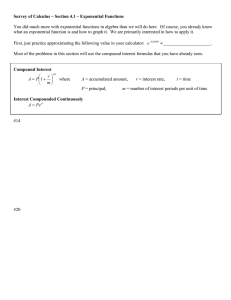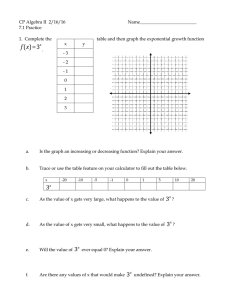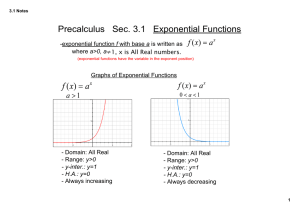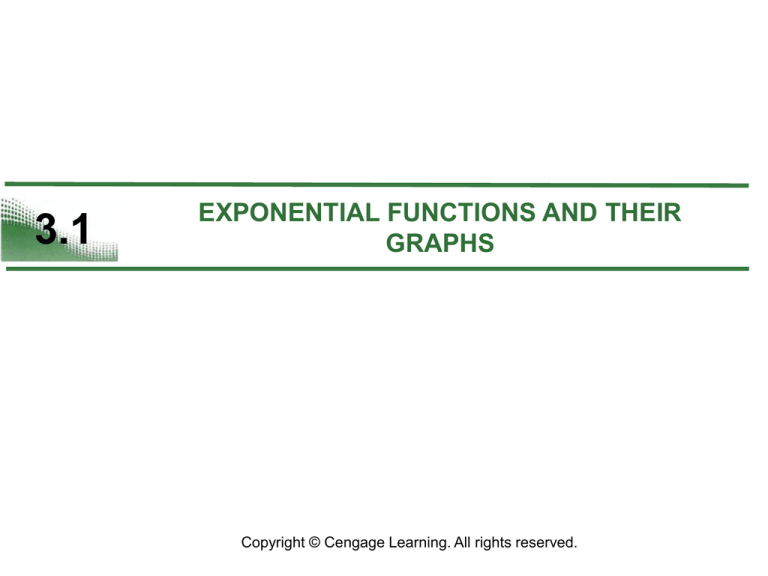
3.1
EXPONENTIAL FUNCTIONS AND THEIR
GRAPHS
Copyright © Cengage Learning. All rights reserved.
What You Should Learn
• Recognize and evaluate exponential functions
with base a.
• Graph exponential functions and use the
One-to-One Property.
• Recognize, evaluate, and graph exponential
functions with base e.
• Use exponential functions to model and solve
real-life problems.
2
Exponential Functions
3
Exponential Functions
Transcendental Functions
f ( x) 4 x
f (3) 4 64
3
1
1
f 42
2
4
Exponential Functions
(where
1.41421356)
as the number that has the successively closer
approximations
a1.4, a1.41, a1.414, a1.4142, a1.41421, . . . .
5
Example 1 – Evaluating Exponential Functions
Use a calculator to evaluate each function at the indicated
value of x.
Function
Value
a. f (x) = 2x
x = –3.1
b. f (x) = 2–x
x=
c. f (x) = 0.6x
x=
6
Example 1 – Solution
Function Value
Graphing Calculator Keystrokes
Display
a. f (–3.1) = 2–3.1
0.1166291
b. f () = 2–
0.1133147
c. f
= 0.63/2
0.4647580
7
Graphs of Exponential Functions
8
Example 2 – Graphs of y = ax
In the same coordinate plane, sketch the graph of each
function.
a. f (x) = 2x
b. g(x) = 4x
9
Graphs of Exponential Functions
Graph of y = ax, a > 1
• Domain: (
• Range: (0,
,
)
)
• y-intercept: (0, 1)
• Increasing
• x-axis is a horizontal asymptote (ax→ 0, as x→
).
• Continuous
10
Graphs of Exponential Functions
Graph of y = a–x, a > 1
• Domain: (
• Range: (0,
,
)
)
• y-intercept: (0, 1)
• Decreasing
• x-axis is a horizontal asymptote (a–x → 0, as x→
).
• Continuous
11
Graphs of Exponential Functions
For a > 0 and a ≠ 1, ax = ay if and only if x = y.
One-to-One Property
12
The Natural Base e
13
The Natural Base e
natural base
e 2.718281828 . . . .
natural exponential function
f (x) = ex
14
Example 6 – Evaluating the Natural Exponential Function
Use a calculator to evaluate the function given by
f (x) = ex at each indicated value of x.
a. x = –2
b. x = –1
c. x = 0.25
d. x = –0.3
15
Example 6 – Solution
Function Value
Graphing Calculator Keystrokes
Display
a. f (–2) = e–2
0.1353353
b. f (–1) = e–1
0.3678794
c. f (0.25) = e0.25
1.2840254
d. f (–0.3) = e–0.3
0.7408182
16
Applications
17
Applications: Continuously Compounded Interest
Suppose a principal P is invested at an annual interest rate r,
compounded once per year. If the interest is added to the
principal at the end of the year, the new balance P1 is
P1 = P + Pr
Year
0
1
2
3
…
…
t
= P(1 + r)
Balance After Each Compounding
P=P
P1 = P(1 + r)
P2 = P1(1 + r) = P(1 + r)(1 + r) = P(1 + r)2
P3 = P2(1 + r) = P(1 + r)2(1 + r) = P(1 + r)3
Pt = P(1 + r)t
18
Applications
Let n be the number of compoundings per year and let t be
the number of years.
Then the rate per compounding is r/n and the account
balance after t years is
Amount (balance) with n compoundings
per year
If you let the number of compoundings n increase without
bound, the process approaches what is called continuous
compounding.
19
Applications
In the formula for n compoundings per year, let m = n/r.
This produces
Amount with n compoundings per year
Substitute mr for n.
Simplify.
Property of exponents
20
Applications
As m increases without bound, the table below shows that
[1 + (1/m)]m→e as m → .
From this, you can conclude that
the formula for continuous
compounding is
A = Pert.
Substitute e for (1 + 1/m)m.
21
Applications
22
Example 8 – Compound Interest
A total of $12,000 is invested at an annual interest rate of
9%. Find the balance after 5 years if it is compounded
a. quarterly.
b. monthly.
c. continuously.
23
Example 8(a) – Solution
For quarterly compounding, you have n = 4. So, in 5 years
at 9%, the balance is
Formula for compound interest
Substitute for P, r, n, and t.
Use a calculator.
24
Example 8(b) – Solution
cont’d
For monthly compounding, you have n = 12. So, in 5 years
at 9%, the balance is
Formula for compound interest
Substitute for P, r, n, and t.
Use a calculator.
25
Example 8(c) – Solution
cont’d
For continuous compounding, the balance is
A = Pert
Formula for continuous compounding
= 12,000e0.09(5)
Substitute for P, r, and t.
≈ $18,819.75.
Use a calculator.
26

